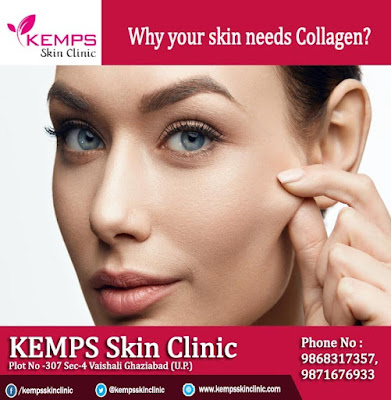Vitamin C is a vital and multi-functional ingredient for
glowing skin and a radiant complexion. It can assist in helping the skin’s
ability to heal itself and minimise scar formation. Normal skin contains high
concentrations of vitamin C, which supports collagen synthesis and antioxidant
protection.
As we age, our levels of vitamin C and collagen production decrease. So, if you’ve been on the fence about this key ingredient, here are five very important reasons why it should be included in your skincare routine:
As we age, our levels of vitamin C and collagen production decrease. So, if you’ve been on the fence about this key ingredient, here are five very important reasons why it should be included in your skincare routine:
1. Best antioxidant:
Antioxidants are substances that have the capability to provide
protection against oxidative stresses by scavenging free radicals. Free
radicals are highly reactive molecules with unpaired electrons. I like to think
of them as the relative you try to avoid at a family gatherings but you just
can’t escape them, they follow you around until they have you cornered. Because
of their instability, they can damage other molecules found within our cells
like proteins, lipids and nucleic acids.
Free radicals are generated through our metabolic processes
and accelerate as we age and our defence mechanisms decrease. They're also
generated when our skin is exposed to UV radiation, toxins and pollution which
leads to accelerated ageing as our cellular structures become more prone to
damage.
This is where Vitamin C saves the day. It works in two different ways to counteract the damaging effect of free radicals: As an effective scavenger, it provides electrons to neutralise free radicals and it regenerates vitamin E (alpha-tocopherol) levels in the skin.
This is where Vitamin C saves the day. It works in two different ways to counteract the damaging effect of free radicals: As an effective scavenger, it provides electrons to neutralise free radicals and it regenerates vitamin E (alpha-tocopherol) levels in the skin.
2. Its promotes collagen synthesis: Collagen and elastin are the primary
structural proteins of the dermis that provide strength, support. and
elasticity. As we age, collagen and elastin production begin to slow down
leading to the first visible signs of skin aging and wrinkle formation.
Vitamin C assists in promoting and influencing collagen synthesis as well as
creating changes in the collagen molecule aiding the overall appearance and
suppleness of the skin. It has the ability in reducing fine lines and wrinkles
leaving you with naturally youthful appearing skin.
3. Reduce photo damage : Vitamin C can also reduce
photo damage due to its ability to regulate collagen synthesis. On its own,
Vitamin C is not a sunscreen. It doesn’t absorb light in the UVA and the UVB
spectrum in the same way as a sunscreen can, but it can assist in limiting the
damage induced by UVA and UVB rays of the sun due to its antioxidant
function.
Topically-applied combinations of vitamin C and vitamin E
are more effective in preventing photo damage when they are combined in a
formulation. Our Vital C Elixir also contains a
specific extract derived from Knotgrass that works on protection from IR
(infrared) damage from the sun.
4. Anti Pigmenting agent: Vitamin C helps reduce skin
discoloration and pigmentation. It’s able to target stubborn skin
discolorations like redness, hyperpigmentation, and under-eye circles. Vitamin
C helps to brighten the complexion making your skin appear more radiant and
healthy.
As we age, our skin is characterized by hyperpigmentation or age spots where the skin appears darker in colour in comparison with the normal surrounding skin. This occurs when an excess of melanin forms deposits in the skin. They are most frequently found on the backs of the hands and the face.
Topically-applied vitamin C has the cosmetic effect of fading of dark spots and brightening the skin. When combined with liquorice root, it has an even greater effect on reducing the visible signs of hyperpigmentation.
As we age, our skin is characterized by hyperpigmentation or age spots where the skin appears darker in colour in comparison with the normal surrounding skin. This occurs when an excess of melanin forms deposits in the skin. They are most frequently found on the backs of the hands and the face.
Topically-applied vitamin C has the cosmetic effect of fading of dark spots and brightening the skin. When combined with liquorice root, it has an even greater effect on reducing the visible signs of hyperpigmentation.
For more skin related query you may contact KEMPS Skin
Clinic, Vaishali, Sec-4 Ghaziabad where you find the solution for your all skin
care needs.






